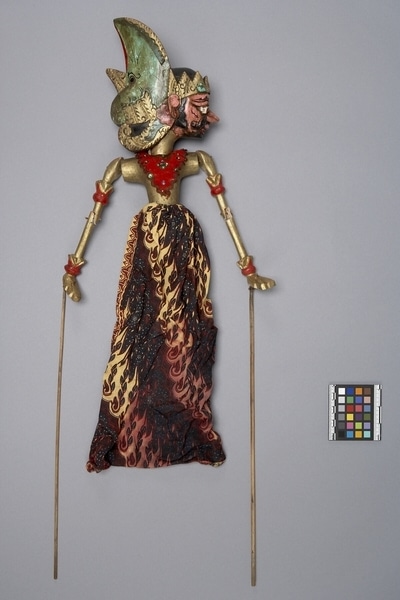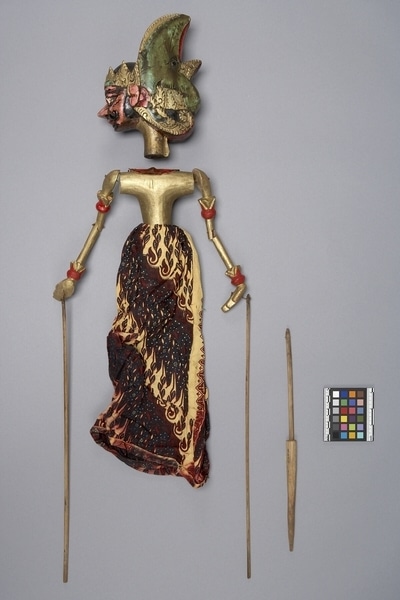Rod Puppet Item Number: Ib409 a-c from the MOA: University of British Columbia


Description
Three-dimensional male humanoid puppet: large head (part b) fits into body with skirt (part a), and a control rod (part c) with a long shaft that passes through the body and fits into the neck of the figure's head. The body has jointed arms, each with a long controlling rod attached. Discoloured pink face positioned forward with bulging white eyes (red irises), red lips, and white teeth. Deeply furrowed brows and pyramidal nose. Large moustache, beard, and sideburns in black. Large headdress with gold diadem, black cap, and backwards facing Garuda Mungkur (short tongue) in green, red, and gold (sekar kluwih headdress), and single siyung jawi. Long gold and blue sumping. Gold neck and broad upper body; each arm has gold and red ornaments at bicep and wrist. Hands held flat and bent back at wrist. Red chest covering (only) with brown wavy trim, sequins and beads. Slight discolouration at collar. Long batik skirt with blue and purple detail.
History Of Use
Javanese puppetry as an art form probably developed by the 11th century. Wayang golek puppets of western Java appeared during the 16th century. Originally the plays depicted Javanese mythology, but after the Indian conquest of Java the Hindu epics, Ramayana and Mahabharata, were incorporated into the cycles, which comprise about 200 plays. A dalang (puppet master) performs the plays to celebrate important occasions, usually in three acts, with vocal and instrumental accompaniment. Typically they serve a moral and religious purpose, and more recently, one of political commentary. Suyudana is an important Kurawa brother, found in the Mahabharata cycle. He is involved in the usurpation of the Pandawa brothers, and the ensuing conflict. Suyudana is characterized as dumb, lewd, and highly crass.
Cultural Context
Theatrical performance.
Iconographic Meaning
Each puppet is characterized by its wanda, a Javanese word which describes the specific mixture of elements of size, form, colour, ornamentation and carving. Pink face denotes anger or aggressiveness; position of face and eyes, and red irises do not suggest virtue or refinement. Other facial features, especially brow and nose, are very unrefined. Headdress, batik, position of hands, and arm ornaments indicate some nobility. Character not identified; possibly (?) a variation of Suyudana as headdress matches closely except for lack of badong.
Item History
- Made in Java, Indonesia
- Owned by Donald Bone before January 4, 1980
- Received from Donald Bone (Seller) and Museum of Anthropology Donations Fund (Funding source) on January 4, 1980
What
- Name
- Rod Puppet
- Identification Number
- Ib409 a-c
- Type of Item
- puppet
- Material
- wood, cotton fibre, fibre, paint and dye
- Manufacturing Technique
- carved, painted, tied, woven and sewn
- Part A
- height 65.5 cm, width 18.5 cm, depth 7.0 cm
- Part B
- height 22.0 cm, width 9.5 cm, depth 16.0 cm
- Part C
- height 34.7 cm, diameter 1.6 cm
Who
- Culture
- Sundanese
- Previous Owner
- Donald Bone
- Received from
- Donald Bone (Seller) and Museum of Anthropology Donations Fund (Funding source)
Where
- Holding Institution
- MOA: University of British Columbia
- Made in
- Java, Indonesia
When
- Ownership Date
- before January 4, 1980
- Acquisition Date
- on January 4, 1980
Other
- Condition
- fair
- Accession Number
- 0586/0029 a-c